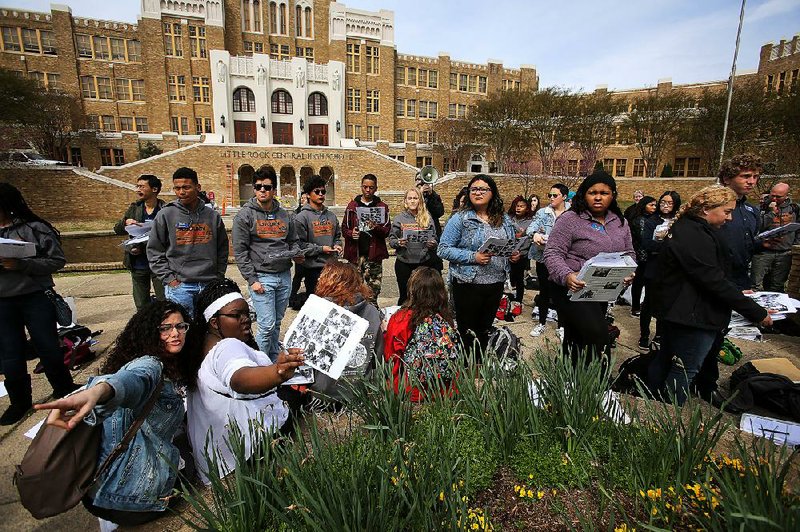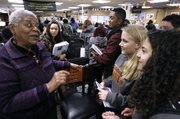Before this week, one of the only things high school junior Sofia Dos Santos knew about the Little Rock Nine was that there were nine of them.
Dos Santos, from San Bruno, Calif., had not walked the path the nine black students took to integrate Little Rock Central High School in 1957.
She had not seen the historic gas station across the street, forever frozen at 22½ cents per gallon, or pictured white high school students jumping from windows to avoid their black classmates.
Nor had she listened to one of the Little Rock Nine describe being body-slammed during a regular school day.
Dos Santos and 49 other students, mostly from California and Ohio, did all of those activities Thursday as part of an immersive civil-rights tour through Southern states.
The program, called Sojourn to the Past, takes students on a dayslong journey to cities with historical importance such as Memphis; Birmingham, Ala.; Jackson, Miss.; and Little Rock.
Many of the students visiting Arkansas on Thursday had never been to the South. At least one had never been outside her state's borders.
Students in the program don't just visit monuments and museums. They speak with civil-rights legends like U.S. Rep. John Lewis and Elizabeth Eckford of the Little Rock Nine.
"It's pretty crazy," Dos Santos said of the experience while copying down a quote inside the Little Rock Central High National Historic Site.
"You don't actually think you're going to see people who changed history," she said.
That aspect appealed to Catherine Leno, a 17-year-old junior from Martinez, Calif.
While exploring the exhibit, Leno scribbled questions that came to mind on a page of notebook paper: What did "separate but equal" look like in their heads? Why was everyone scared of integration?
Little Rock was the fifth of six destinations on the tour. Learning from the people who actually shaped history, like Eckford, is easily the best part, Leno said.
[THEN AND NOW: Compare 1937, 2017 photos of Central High]
It's different from a lecture because "people give emotion when they talk," as opposed to reading a book and "guessing how they're feeling," Leno said. She's seen "a lot of sadness," but also glimpses of happiness, from the speakers on the tour, the teen added.
In Little Rock Central's library, with fellow Little Rock Nine icon Minnijean Brown Trickey in the audience, Eckford said talking to students about the hatred she experienced used to be quite difficult.
"When I first started talking to students in 1999, I cried a lot," Eckford told the Sojourn students. "I'm not so weepy anymore, and it's because you've made me stronger."
She described an America that's foreign to them.
Earlier that morning, the teenagers pictured the walk Eckford took through a spitting and screaming mass of people on Sept. 4, 1957, the first day the black students attempted to enter the high school but were blocked by the Arkansas National Guard.
On Sept. 23, after the Guard had withdrawn through federal intervention, the black students were briefly escorted into the school by police while 1,000 angry white people protested, Eckford explained. The mob caught sight of three black journalists, one of whom was L. Alex Wilson.
Wilson decided not to run away and was "beaten, knocked down, throttled," Eckford said. A man circled the journalist with a brick in hand, searching for a soft spot before he landed a severe blow.
Wilson, a dogged reporter, died in 1960 of what was likely damage from the beating, according to the Lowell Milken Center for Unsung Heroes.
As for her white classmates, "there are some that say they welcomed us," Eckford said. "They must have kept it to themselves, because I didn't see that."
She was scalded in the high school shower four times, she said. Each time, Eckford saw that the girls showering around her had already turned off their water. They were not the ones to flush the toilet to make the water hot, but they were prepared.
"If you're a bystander, it makes the person being bullied feel like they're getting what they deserve," Eckford said.
"If you support someone who's been set aside and taunted and hurt, you can help someone live another day," she added.
Outside, in the courtyard of the high school, students pledged to be conscious of cruel and prejudiced language at the prompting of Jeff Steinberg, who founded Sojourn to the Past and led Thursday's tour.
The teenagers wrote letters to themselves in loopy script about how to be better citizens.
Steinberg asked them to raise their hands if they thought Eckford would have a different life today if somebody had helped her then.
Fifty hands lifted from laps into the air.
Metro on 04/06/2018

